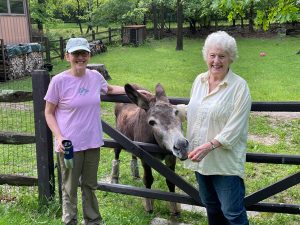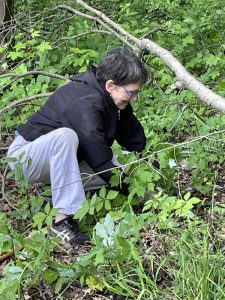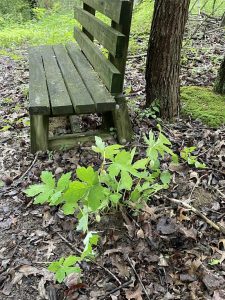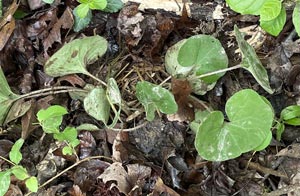
The older folks among us may remember taking vacations in the car when we were kids. Every time dad stopped for gas, he had to clean the bugs off the windshield. When was the last time you had to clean large numbers of bugs off your windshield?
Insect populations on earth have declined 45% in the last four decades. No matter how you feel personally about bugs, our food supply and the health of ecosystems depend on them. The largest driver of insect decline is habitat loss, but another important factor is the prevalence of non-native species of vegetation. Local insects have evolved to eat local plants, and many are very specific in their needs. Without the pressure of insects feeding on them, non-native plants can out-compete native plants, crowding them out of the forests and fields where they once thrived.
Cincinnati Friends Meeting is doing our small part to provide more food and habitat for native insects and the birds who eat them by planting native species on our property. A small group gathered in January to begin considering the possibilities. An ad hoc committee under the oversight of the Board of Trustees, and now including Debbie Miller, Marjorie Isaacs, Sabrina Darnowsky, Vicki Culler, Jeff Clark and Carole Barnhart, the group has begun assessing CFM’s property for native and non-native species and devising a plan for reducing the number of non-natives and increasing native species.

The group observed that during the spring months, when woodland flowers bloom in the sunlight that reaches the forest floor before trees leaf out, our typical local flowers are being crowded out by non-native species. In May, Debbie Miller graciously shared the bounty of her wooded property, and the group was able to plant Virginia bluebells, Mayapples, wild ginger, large-leaved waterleaf, wood poppies, wild geraniums and bloodroot along the trails in the woods.
Also in May, the group hosted two forestry experts at our property. Ohio Department of Natural Resources Forester Pat Migliozzi and Professor of Silviculture and Extension Specialist at Ohio State University Dr. Andrew Londo toured the woodlot behind the meetinghouse and assessed it for diversity and for invasive non-native plants. Among the surprises were their observation that a plant the group thought was invasive bamboo is actually river cane, a species of bamboo native to North America. They discovered that the property hosts a Kentucky Coffeetree, with its lacy leaflets and unique bark, and perhaps most interestingly, the pair found one healthy ash tree, which seems to be resistant to the ravages of the Emerald Ash Borer insect that has decimated ash trees across the United States. Plans are being made to implement the experts’ suggestions for preserving unique native species and controlling the non-natives that are currently crowding out natives.

The native plant group is also researching options for supporting the local ecosystem by planting gardens filled with native species that are specifically used by pollinating insects. The group has consulted with the Cincinnati Nature Center to gain information on how best to select and plant these natives, with the goal that some plants will be in bloom at all times throughout the growing season. Those plants will likely be planted in the fall.
It used to be thought that native plants must occur in large unbroken tracts to have an impact on local biodiversity, but recent research is indicating that even our small gardens will help support local insect populations and the wildlife that they feed.


The Trustees are thrilled and excited to support this “grassroots” initiative.
It is exciting to learn what the group bringing to CFM. Keep up the good work.